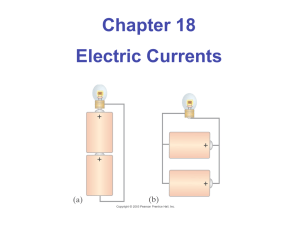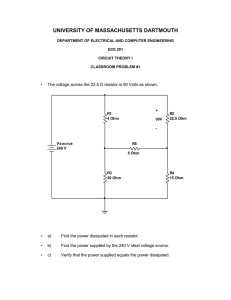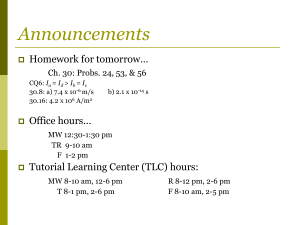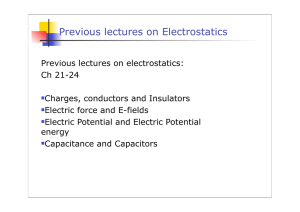2/14 - Physics at SMU
advertisement
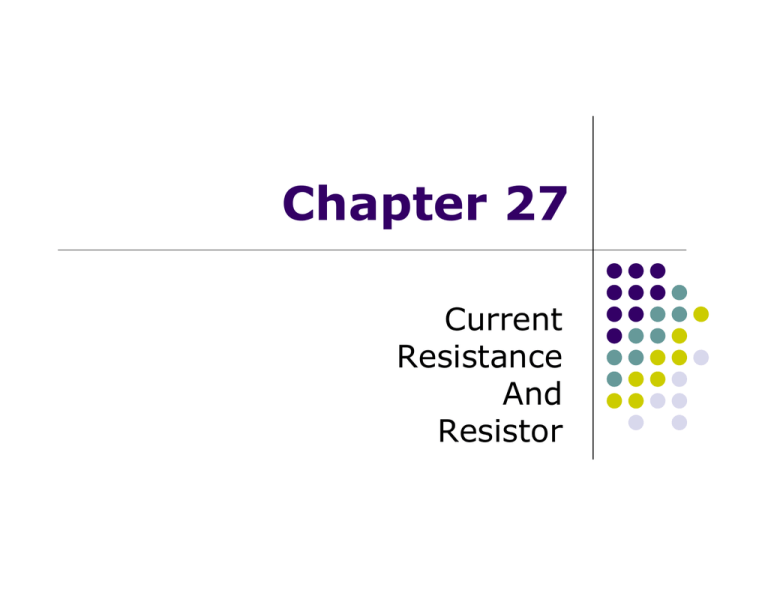
Chapter 27 Current Resistance And Resistor Review The current is defined and its unit is ampere (A), a base unit in the SI system. + + + A + dQ I= dt + + I The charges passing through the area could be positive or negative or both. They are called charge carriers. Current direction is chosen to the electric field direction or the direction as the flow of positive charges. Review The motion of the charge carriers is the result of the movement driven by the electric field plus random collisions with other particles in the conductor. The average velocity of thismotion is called the drift velocity Vd E The current and the drift velocity has a linear relationship. I = nqv d ⋅ A n is the number of charge carriers per unit volume. q is the carrier charge The drift velocity is very small. What is actually prorogating in the conducting wire is the electric field. So the conducting wire is actually the carrier or guide for the electric field, which delivers the electric power. Current Density J, the definition The current density J of the current I a conductor is defined as the current per unit area I = ∫ J ⋅ dA Compare with, I = nqv d ⋅ A one has: J = nqVd J has SI units of A/m2 Current density is a vector and is in the direction of the positive charge carriers, or in the direction of the electric field. Conductivity and Ohm’s Law For some materials, the current density is directly proportional to the electric field: J = σE The constant of proportionality, σ, is called the conductivity of the conductor. Another often used parameter is resistivity, ρ, is just inverse of the conductivity: ρ = 1/σ And this formula, J = σE is called Ohm’s Law. Ohm’s Law Ohm’s law states the ratio of the current density to the electric field is a constant σ Mathematically, J = σ E Most metals obey Ohm’s law Materials that obey Ohm’s law are said to be ohmic But Not all materials follow Ohm’s law Materials that do not obey Ohm’s law are said to be nonohmic Ohm’s law is not a fundamental law of nature Ohm’s law is an empirical relationship valid only for certain materials Resistance and a more popular form of Ohm’s Law l From Ohm’s Law: J = σ E E One has: E = 1 σ J = ρJ Now exam the section of wire with length l and cross section A, one has: I l ∆V = El = Jl = ρ Jl = ρ l = ρ I σ A A 1 Now we define a new parameter, the resistance of this section of the wire, R: l R≡ρ A Ohm’s Law becomes ∆V = RI or R≡ ∆V I Resistance, discussion SI units of resistance are ohms (Ω) 1Ω=1V/A SI units of resistivity are Ω·m Resistance proportional to the resistivity constant of the material, the length of the conductor (wire), inversely proportional to the cross section. In a conductor, the voltage applied across the ends of the conductor is proportional to the current through the conductor The constant of proportionality is called the resistance of the conductor l R≡ρ A ∆V = RI R≡ ∆V I Resistivity Values and the temperature coefficient α Resistance and Resistors All (almost) materials have resistance Those that are call ohmic if Ohm’s Law R ≡ ∆V holds. I In a circuit, the resistance of connecting wires (PCB copper traces) are often neglected. A device made to have certain resistance value is call a resistor. Ohmic Material, Graph For an ohmic device The resistance is constant over a wide range of voltages The relationship between current and voltage is linear The slope is related to the resistance Nonohmic Material, Graph Nonohmic materials are those whose resistance changes with voltage or current The current-voltage relationship is nonlinear A junction diode is a common example of a nonohmic device Resistance and Temperature Over a limited temperature range, the resistivity of a conductor varies approximately linearly with the temperature ρ = ρo [1 + α (T − To )] ρo is the resistivity at some reference temperature To o To is usually taken to be 20 C α is the temperature coefficient of resistivity SI units of α are oC-1 With a resistor: R = Ro [1+ α (T − To )] This is often used to measure temperature with materials that have large α Resistivity and Temperature, Graphical View For some metals, the resistivity is nearly proportional to the temperature A nonlinear region always exists at very low temperatures The resistivity usually reaches some finite value as the temperature approaches absolute zero Electrical Power: work down by the electric field in the circuit As a charge Q moves from a to b, the electric potential energy of the system increases by Q∆V so This energy comes from the chemical energy in the battery Q As the charge moves through the resistor (c to d), the system loses this electric potential energy, turning Q it to heat by the resistor The electric power (energy time rate) the resistor consumes is dQ energy Q∆V because I ≡ p= = = I ⋅ ∆V time t dt p = I ⋅ ∆V 2 ∆ V With Ohm’s Law: p = I 2R = R PLAY ACTIVE FIGURE Electric Power, to summarize The electric power is given by the equation: p= I ∆V and is always correct. If Ohm’s Law is applicable, alternative expressions are often useful: 2 p= I∆V =I 2 ∆V ) ( R= R Units: I is in A, R is in Ω, V is in V, and p is in W Example: Electric Power Transmission The question: Dallas needs 100 MW electric power which is generated 100 miles away. The transmission line (aluminum) has a diameter of 2 inches. How much power must be generated to deliver 100 MW to Dallas, (a) If 110 V is used? (b) if 600,000 V is used? Example: two incandescent light bulbs In the US, the standard in our grid power system is 110 V. When two incandescent light bulbs (a pure resistive device, with light output proportional to the power consumed), with power specifications of 60 W and 100 W, are connected in parallel, which one is brighter? Example: two incandescent light bulbs Now connect them in series, which one is brighter in this case?



